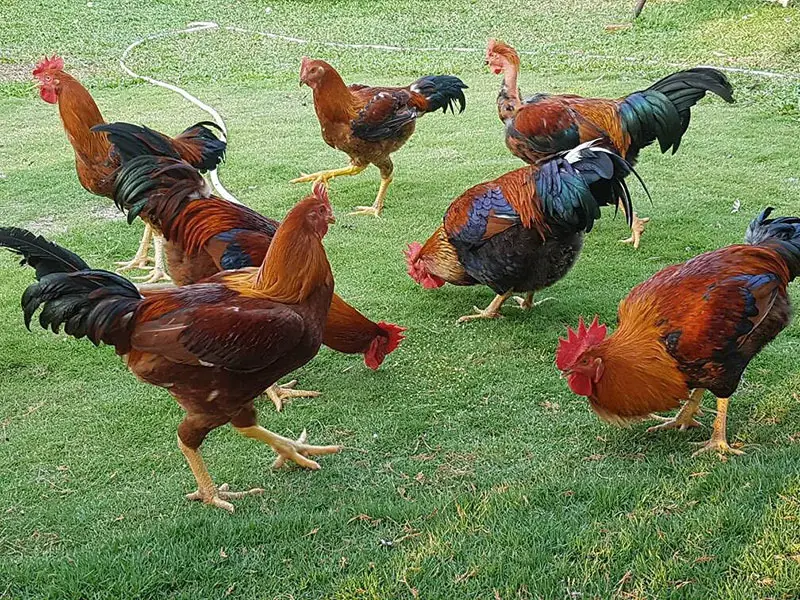Raising and caring for hens, and newborn chicks in particular, is a demanding, satisfying, and confidence-boosting endeavor that has its share of challenges and rewards. If you’ve ever had to raise chicks, you understand how difficult it can be since they have a lot of demands and requirements until they are mature enough to be more self-sufficient. They need roomy, comfortable, and tidy surroundings; enough light that also acts as a heat source; and food that will accelerate their development.
Farmers utilized heat lamps for many years to assist provide newborn chicks with enough warmth to accelerate their development. There are a number of risks associated with utilizing heat lamps for hens, so you should explore for other options.
When the chicks’ coop is big enough to sustain their warmth, using heat lamps or ceramic lamps is occasionally permissible; nevertheless, it may cause the chicks to feel uncomfortable by making them feel both hot and cold.
The 250W lightbulbs with reflectors that are placed above the brooders for newborn chicks are often known as heat lamps. Its primary function is to provide newborn chicks warmth, taking the place of their mothers’ protective demeanor. Still, there are a number of drawbacks. A survey claims that for hens to be warm enough, the temperature should be between 90 and 95 degrees Fahrenheit.
There are several reasons why using heat lamps on newborn chicks is not a good idea; fortunately, there are plenty of alternatives. Baby chicks lack the independence to figure out how to remain warm, have brittle feathers, and lack development in their feathers.
Fortunately, this post will discuss ways to keep newborn chicks warm without the need for a heat light. These procedures will enable young chickens to maintain a constant body temperature, and because birds have warm blood, you won’t overheat them. To find out more, keep reading.
The Perils of Heating Lamp Use for Hens
There are drawbacks to employing heat lamps for chicken brooders, as was previously discussed in the article. This section will enumerate these drawbacks. Despite farmers being able to utilize them effectively for decades, it’s crucial to be aware of them.
Electrical issues: Make sure the item is correctly connected to the chord or extension cord and that the power cord is out of the hens’ reach. Occasionally, the cable may be destroyed by the chicks biting on it or attempting to touch it, which might put the chicks and anybody keeping an eye on them at risk of electrical shock.
Fire Hazard: There is a chance of a fire if you use an outdated or broken heat light. There’s still a chance that the lamp may come loose and catch fire, even though most people make sure everything is fastened tightly. This might happen to the wooden components of the brooder as well as the straw that has been placed within. The defenseless newborn chicks might perish as a consequence of the undiscovered fire in the middle of the night.

Uneven Heat Distribution: A heat lamp is a concentrated source of heat, so be mindful of this if you must use one. Some hens may feel overheated in a large brooder, while others may feel too chilly if the brooder is too large or placed too far from the center.
Overheating: Dehydration and overheating may result from a brooder that is too chilly or too near to the newborn chicks. Because they are warm-blooded creatures, chickens have internal thermoregulation systems. They dislike feeling overheated and maybe dehydrated, however. Baby chicks have immature temperature-regulating systems and are tiny and delicate.
Mood Shifts: Chickens and chicks who are raised under artificial lighting all the time may have behavioral issues. They won’t be able to exercise various coping strategies or cultivate survival instincts, which will prevent them from becoming independent. Over-reliance on artificial heat sources may lead to weakened immunity in later life.
They’re Not Indestructible: Regretfully, lightbulbs for heat lamps may break if they fall. Broken glass fragments not only present a danger of fire, but they also have the potential to cause injuries to young chicks if they are scattered around the brooder and coop.
Alternatives to Heat Lamps for Chickens
With a little more assistance, chickens and young chicks can easily stay warm on their own. These substitutes will help you stay away from heat lights permanently. Continue reading!
Warm Plates
Without altering the intended function, heat plates are the most often used substitute for heat lamps for both hens and infant cheeks. The absence of fire danger is the finest feature. There are two types of heat plates available: vertical and horizontal.
For young chicks, horizontal heat plates work best; for other flock birds, such ducks, vertical heat plates work better. However, if your hens are older and need natural warmth, you may use vertical ones. Think of it as a raised plate that is just low enough for tiny chicks to crawl beneath.
Put another way, they resemble a mother hen tending to her young, with the exception that the horizontal plate generates just the right amount of heat. It uses less power than the 250-watt heat lamps, which have a higher danger of fire and a host of other potential electrical issues.
You may resize the plate as the chicks become larger and stronger every day to ensure that every chick can fit in and take advantage of the warmth. Because they may freely walk away from the plate, baby chicks are perceptive enough to select whether or not they wish to be warmed by it.
It doesn’t immediately heat the air. Rather, it heats the items that collect underneath it, allowing the young chick to simply move away and find a freshwater source in the brooder to cool off if it becomes too hot. Even newborn chicks have preferences, so while some may want to feel warmer, others may want to chill off.
Editor’s note: There are a variety of heat pads available, and each one has unique features and characteristics. The Ecoglow 20, which is appropriate for both newborn ducklings and chicks, is our favorite. As an alternative, you may want to think about the PoultryKit Brooder, which has equally incredible features.
Warmth Cushions
Electric heating pads could be a better choice for chickens and their offspring if the heat plates and their characteristics aren’t heating you up. Numerous newborn animals, including chicks, ducklings, piglets, and others, are kept warm using heat pads. You will need to hide them someplace secure since they are electrically charged. You may place them on the wall or place a waterproof cloth below the chicks.
Typically, heating pads come with a thermostat that provides a precise temperature reading of the pad, allowing you to know whether the chicks are sufficiently warm or need extra warmth. You may also avoid overheating in this manner.
Many individuals make a fake heat plate by placing heat pads on top of metal plates in order to save money. This is an excellent substitute if your budget is a constraint. Though it’s important to note that heat pads consume a lot less power than heat lamps, many people are worried that they might also be a source of electrical risks.
In addition, they have a very minimal burn danger and don’t produce artificial light. Finally, you won’t have to worry about glass fragments breaking and scattering around the brooder and coop.
Editor’s note: There are a lot of heat pads available on the market, just as there are heat plates. The K&H thermos-peep heated pad and the incredible GABraden huge chicken heated pad would be our top picks if we had to choose. When you have a large number of newborn chicks, it’s perfect, particularly if you want to take them outside.
Deep Litter Approach
In the winter, deep litter is a common strategy for keeping your hens warm. If you can tolerate a strong smell, it may also help keep your fledgling chicks warm. How does it operate? It implies that you will replace the old, filthy bedding in the chicken coop or brooder on a regular basis.
The excrement and other hen-derived compost will not be removed. Rather, you will let it decompose into compost before adding another layer of dirty bedding on top of it. Your hens may now lay on a heated floor throughout the coop and enclosure thanks to this.
This is a great approach to keep your hens warm throughout the chilly winter days and nights since the coop will warm up naturally. You won’t have to be concerned about costly electrical costs or about glass fragments breaking and injuring your daughters. There is no danger to anybody and the area will naturally warm up.
Bottles of Hot Water
Heat lamps may be more expensive than using hot water bottles, whether you’re raising hens or young chicks. However, since the hot water bottles must be changed often, it requires a lot of effort and upkeep. However, if you want to provide your chicks a temporary source of heat, they’re a fantastic alternative.
This is perfect for pullets and cockerels, or newborn chicks that are a few weeks old. you prevent your hens from being injured, make sure you use towels to insulate the hot water bottles so they won’t get too hot to lie on or stand on top of them.
Organic Cover
This technique is effective for keeping adult hens and roosters warm, but it is not recommended for use with young chicks. A clear plastic cover that doubles as a shelter may be placed over the enclosure and the coop.
Even so, think about building a windbreak to provide enough ventilation. Make sure that no wind enters the coop while using this ventilation method, and that the hens won’t get wet from persistent rain, hail, or snow. This is an excellent method for warming up your hens without using power or creating a fire danger.
Using a thermometer, find the temperature
You are under no need to employ a heat light on a constant basis if that is your choice regarding your hens. Using a thermometer that can measure the temperature in the brooder or coop properly or one with an integrated thermostat is the best approach to determine whether the chicks are overheating.
By doing so, you’ll be able to gauge how hot is too hot and switch off the heater so the chicks may relax from the constant source of light in their eyes or enjoy some ambient light.
Infrared Light Bulbs
You may use infrared lamps in place of the heat lamp, which uses a 250W electrical light source. Although there is still a chance that the bulb may fall into the brooder and break off, scattering hundreds of glass fragments around the coop, the danger to the chicks and hens residing in the coop is much reduced.
It is considerably softer and less stressful for chicks to be around infrared light, which is emitted by infrared lamps. Without upsetting or upsetting them, it permeates inside the coop and makes them feel cozy. This kind of light is less likely to start a fire since it uses less energy to operate.
A research found that exposure to infrared light improves adults’ circadian rhythm and quality of sleep. It also implies that hens that won’t be harmed by a bright light source shining on them constantly would benefit more from it. It is also less likely to result in lower-quality eggs that are produced by intense light sources within the coop.
Editor’s note: It’s important to highlight that optical lightbulbs are also an option, provided that they don’t use excessive amounts of electricity. 60–75 watt lightbulbs will provide a chicken coop with enough heating energy during the chilly winter days, and will also suffice for newborn chicks.





